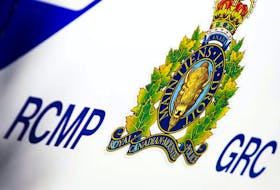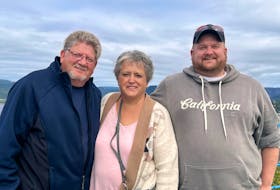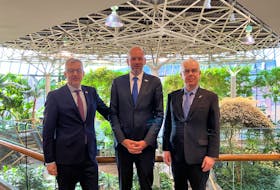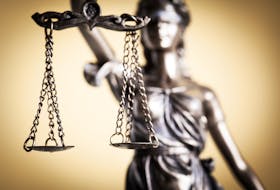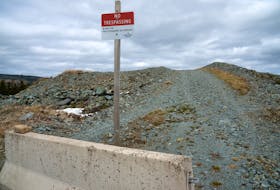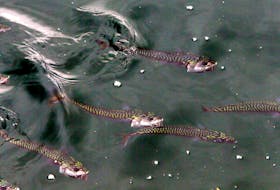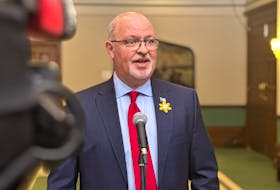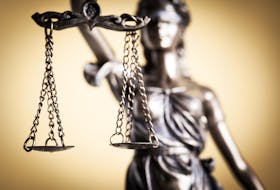Testifying in Stacey’s second-degree murder trial at Newfoundland and Labrador Supreme Court in St. John’s, Sgt. Jim Smith of the RNC forensic identity section told the jury that when he went to the single-storey residence at 787 Topsail Rd. in Mount Pearl at around 4 p.m. on Jan. 12, 2015, he saw stains at least three locations — on the washer, near the closet and on the wall across from the bathroom.
Smith also said there were clothes in the washer. Stacey’s mother, along with a young boy and teenaged boy were at home at the time.
He said he had obtained a warrant to search the house as a result of an incident that happened the night before.
At around 9 p.m. on Jan. 11, 2015, Comerford had been stabbed multiple times inside a van that had stopped at a nearby cul-de-sac on Greenwood Crescent.
Testimony by the van driver earlier this week revealed that the van was there to pick up Stacey, who, along with four other men in the van, including Comerford, were chicken catchers. They were being shuttled to work the night shift at a local chicken farm.
However, as Stacey was getting in the van, he and Comerford, who was sitting in the bench seat behind the driver, began to argue. The two went outside and were yelling until the driver told the men to get back inside. Stacey sat in the bench seat in the back of the 10-passenger van, two rows behind Comerford.
Seconds later, as the driver was pulling away, he noticed a commotion and saw who he assumed were Stacey and Comerford fighting in the back seat. When he pulled over, Stacey got out of the van and ran off. The driver went back to see what was going on and discovered Comerford had been stabbed in the chest, was bleeding profusely and was gasping for breath. The entire incident was said to have happened in less than a minute.
Comerford succumbed to his injuries shortly afterwards.
Smith took photos of Comerford’s body hours later and also attended the autopsy a few days later.
He said there were six stab wounds in total – three in the chest (two on the left side) and one each in the hand, hip and arm, the latter of which had exited near the tricep.
Some of the photos were compiled in a book, copies of which were handed out to the 13 jurors, with Smith warning that some images may be disturbing.
In cross-examination, defence lawyer Bob Buckingham questioned Smith about his choice of words in direct questioning. Smith had said he was at the Stacey house, “to collect evidence for the prosecution,” but admitted that was a poor choice of words. He said he is objective and that he was there “to find evidence and facts” about the case.
“Our responsibility could be to exonerate someone,” Smith added.
Buckingham said Stacey had been arrested 10:22 p.m. on Jan. 11, 2015, and asked if Smith was jumping to conclusions when he got to the Stacey house the next day.
Buckingham suggested Smith and the whole forensics team had tunnel vision.
Crown prosecutor Phil LeFeuvre objected and the jury was asked to leave the courtroom at that point as Justice Garrett Handrigan spoke with lawyers.
When the jurors returned, the judge told them to ignore Buckingham’s statement about the whole team having tunnel vision. He said lawyers can’t make such broad statements while questioning a witness, as what they say is not evidence.
Buckingham also asked Smith that if Stacey’s clothes were examined, why officers didn’t look to see if there was a pocket or anywhere he could have concealed a knife.
“I don’t recall having that discussion with anyone,” Smith said, adding there would’ve been several places to conceal a weapon in the van.
He said there would’ve been further analysis had the murder weapon been found.
“Only two people know who brought the knife,” Smith said.
Testifying in Stacey’s second-degree murder trial at Newfoundland and Labrador Supreme Court in St. John’s, Sgt. Jim Smith of the RNC forensic identity section told the jury that when he went to the single-storey residence at 787 Topsail Rd. in Mount Pearl at around 4 p.m. on Jan. 12, 2015, he saw stains at least three locations — on the washer, near the closet and on the wall across from the bathroom.
Smith also said there were clothes in the washer. Stacey’s mother, along with a young boy and teenaged boy were at home at the time.
He said he had obtained a warrant to search the house as a result of an incident that happened the night before.
At around 9 p.m. on Jan. 11, 2015, Comerford had been stabbed multiple times inside a van that had stopped at a nearby cul-de-sac on Greenwood Crescent.
Testimony by the van driver earlier this week revealed that the van was there to pick up Stacey, who, along with four other men in the van, including Comerford, were chicken catchers. They were being shuttled to work the night shift at a local chicken farm.
However, as Stacey was getting in the van, he and Comerford, who was sitting in the bench seat behind the driver, began to argue. The two went outside and were yelling until the driver told the men to get back inside. Stacey sat in the bench seat in the back of the 10-passenger van, two rows behind Comerford.
Seconds later, as the driver was pulling away, he noticed a commotion and saw who he assumed were Stacey and Comerford fighting in the back seat. When he pulled over, Stacey got out of the van and ran off. The driver went back to see what was going on and discovered Comerford had been stabbed in the chest, was bleeding profusely and was gasping for breath. The entire incident was said to have happened in less than a minute.
Comerford succumbed to his injuries shortly afterwards.
Smith took photos of Comerford’s body hours later and also attended the autopsy a few days later.
He said there were six stab wounds in total – three in the chest (two on the left side) and one each in the hand, hip and arm, the latter of which had exited near the tricep.
Some of the photos were compiled in a book, copies of which were handed out to the 13 jurors, with Smith warning that some images may be disturbing.
In cross-examination, defence lawyer Bob Buckingham questioned Smith about his choice of words in direct questioning. Smith had said he was at the Stacey house, “to collect evidence for the prosecution,” but admitted that was a poor choice of words. He said he is objective and that he was there “to find evidence and facts” about the case.
“Our responsibility could be to exonerate someone,” Smith added.
Buckingham said Stacey had been arrested 10:22 p.m. on Jan. 11, 2015, and asked if Smith was jumping to conclusions when he got to the Stacey house the next day.
Buckingham suggested Smith and the whole forensics team had tunnel vision.
Crown prosecutor Phil LeFeuvre objected and the jury was asked to leave the courtroom at that point as Justice Garrett Handrigan spoke with lawyers.
When the jurors returned, the judge told them to ignore Buckingham’s statement about the whole team having tunnel vision. He said lawyers can’t make such broad statements while questioning a witness, as what they say is not evidence.
Buckingham also asked Smith that if Stacey’s clothes were examined, why officers didn’t look to see if there was a pocket or anywhere he could have concealed a knife.
“I don’t recall having that discussion with anyone,” Smith said, adding there would’ve been several places to conceal a weapon in the van.
He said there would’ve been further analysis had the murder weapon been found.
“Only two people know who brought the knife,” Smith said.

